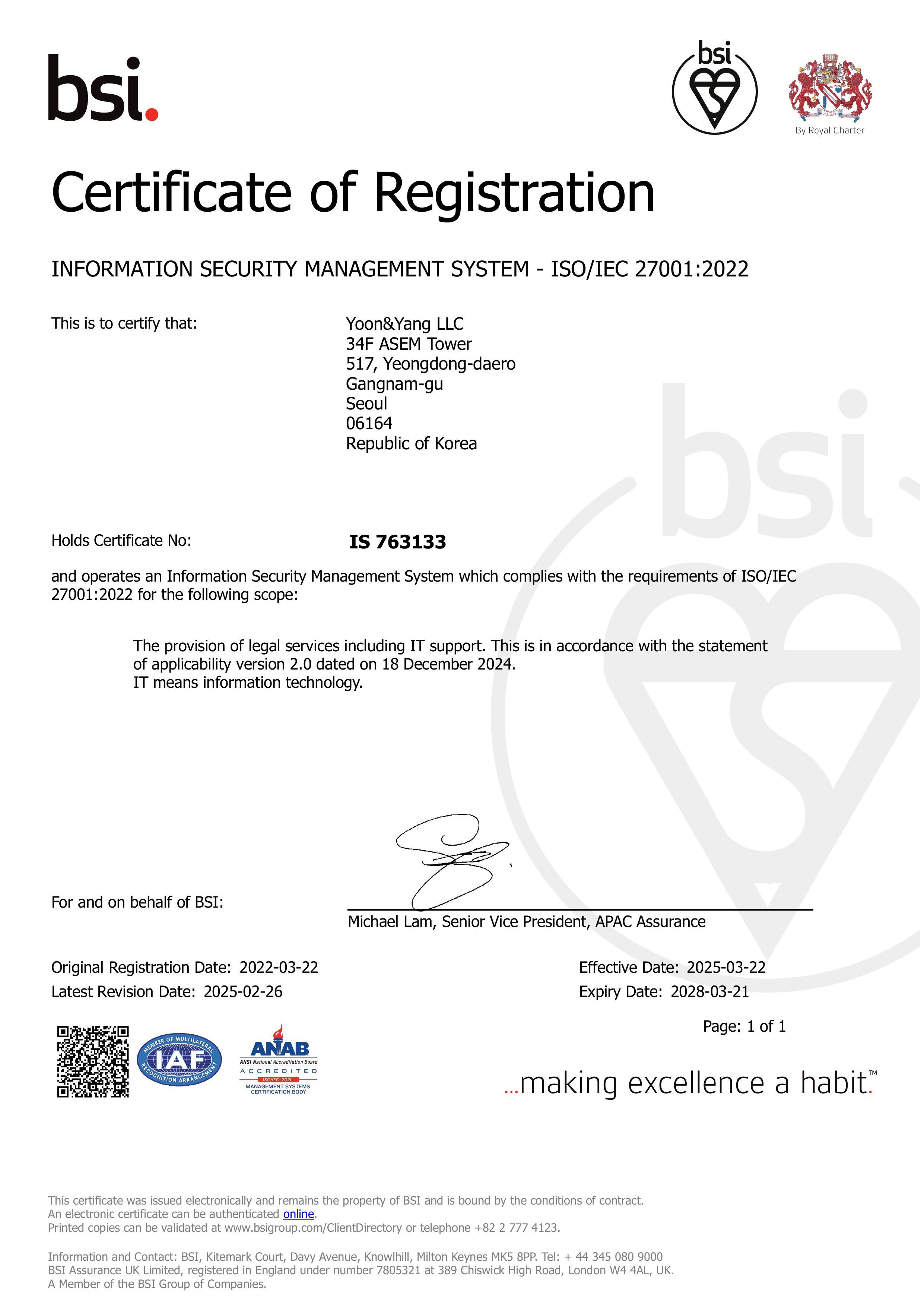본문
A further Amendment to the Korean Commercial Code approved by the National Assembly – Significant implications in the board and audit committee
- Newsletters
- 2025.08.28
In furtherance of significant amendments to the Korean Commercial Code (the “KCC”) approved by the National Assembly on July 3 and promulgated on July 22, 2025 (the “1st Amendment 2025”), an additional set of critical amendments to the KCC (the “2nd Amendment 2025”) was approved on August 25, 2025, as previewed in our previous newsletter of July 9, 2025.
The 2nd Amendment 2025 specifically focuses on the composition of the board and the audit committee of the large-scale public companies in Korea with total assets of KRW 2 trillion or more (approximately USD 1.47 billion)(the “Large Public Companies”). The 2nd Amendment 2025 (i) prohibits opting out of the cumulative voting in director elections (effective from the first general meeting of shareholders to elect directors convened after the promulgation of the 2nd Amendment 2025), and (ii) requires separate election of at least two (2) directors to serve as the audit committee members at the time of their director election (effective one year after promulgation, which is anticipated to be around September 2026).
The 2nd Amendment is expected to bring forth significant changes in the corporate governance of the Large Public Companies. Current management and the board are advised to carefully review and adapt their articles of incorporations and governance systems to effectively address the new requirements. The second or third largest shareholders, minority shareholders, institutional investors, and activist funds may have broader chance of electing of at least two or more directors serving as the audit committee members.
1. Cumulative Voting and Separate Election Requirement
2. Practical Implications
3. Actions Recommended for Large Public Companies
4. What Comes Next
1. Cumulative Voting and Separate Election Requirement
Mandatory Cumulative Voting for Large Public Companies
The current KCC allows shareholders holding 3% or more of voting shares in a joint stock company (or 1% or more in case of the Large Public Companies) to request cumulative voting in director elections. Companies could, however, exclude this requirement if their articles of incorporation (the “AOI”) provides otherwise.
According to statistics as of the end of 2024, among 334 public companies with total assets of KRW 5 trillion (approximately USD 3.67 billion) or more (in aggregation with affiliates), only 13 companies (approximately 3.8%) did not exclude cumulative voting, and only one (1) company actually implemented cumulative voting. This led to continuous debates and ultimately, the 2nd Amendment 2025 eliminates the exception permitting exclusion of cumulative voting (§542-7③, the 2nd Amendment 2025).
Separate Election required for at least Two (2) Directors serving as the Audit Committee Members
Under the 1st Amendment 2025, the Large Public Companies are required to apply the so-called “Aggregated 3% Rule” (which limits the voting rights of the largest shareholder together with its specially related persons to 3%, while other shareholders are individually subject to 3% limit) when electing each and every audit committee member, effective from July 23, 2026.
Previously, we noted its practical importance that it will significantly increase the likelihood of at least one director serving as the audit committee member being elected against the vote of the largest shareholder who is subject to the Aggregated 3% Rule, when applied with the requirement to separately elect at least one (1) director who will serve as the audit committee member at the time of director election (as opposed to an election for audit committee members among the elected directors)(i.e., a “Separate Election” requirement).
We also added that additional future amendment is underway to increase the separate election requirement to two (2) or more directors (serving as the audit committee members), and now the National Assembly approved expansion of the Separate Election requirement to elections of at least two (2) directors who will serve as the audit committee members (§542-12②, the 2nd Amendment 2025).
Now, the 2nd Amendment appears to increases the possibility of at least two (2) or more directors serving as the audit committee member being elected against the vote of the largest shareholder as a result of combined effects of the Aggregated 3% Rule and the Separate Election requirement.
2. Practical Implications
A series of recent amendments to the KCC aims to protect minority shareholder interests by putting the brakes on the influence the largest shareholder may have upon the management of companies. For example, for a Large Public Company with 5 directors, now at least 2/5 of the board members who will be the audit committee members shall be elected against the vote of the largest shareholder under the Separate Election requirement and the Aggregated 3% Rule.
In addition, assuming two or more other directors are elected at the same shareholders’ meeting, the mandatory cumulative voting alone may additionally allow at least one (1) more director elected against the vote of the largest shareholder if other shareholders opt to vote in that way.
Compared to the current corporate practices where the largest shareholders of the Large Public Companies could effectively constitute the boards with all directors as they recommended (by technically avoiding the Aggregated 3% Rule and the Separate Election requirement by filling all audit committee members with outside directors or non-standing directors, and excluding the cumulative voting by the AOI), now the largest shareholders will need to carefully assess the risk of even losing control of the board by allowing three (3) or more directors elected under the influence of the minority shareholders.
On the other hand, the amendments would provide a greater opportunity for the second or third largest shareholders, minority shareholders, institutional investors and activist funds to have their voices heard in the board of the company. The pivotal shift in corporate governance structure mandatorily brought forth by the new amendments might lead to behavioral changes of the activist funds, private equity funds, minority shareholders and other strategic shareholders which would act upon the unified aim to maximize the shareholder value, particularly where the current board has not been successful in delivering fair and equitable value to the shareholders.
While the amendments are expected to diversify boards and enhance internal checks and balances, they may also impede upon the efficiency of business decisions and implementation of strategic investments quintessentially required for long-term interest and subsistence of the company. Behavioral changes of minority shareholders and other substantial shareholders may lead to exhaustive takeover attempts aimed at maximizing short-term interests and snatching control over the company without investing sufficient funds to acquire controlling shares.
For Large Public Companies where the major shareholders entered into strategic joint venture agreement, business cooperation agreement or shareholders’ agreement, the amendments might render certain provisions of those agreement on the corporate governance and board composition unenforceable and all such agreements will need to be carefully revisited and revised to align with the mandatory provisions of the amendments.
3. Actions Recommended for Large Public Companies
Upon promulgation of the 2nd Amendment 2025 in September 2025, the Large Public Companies must not exclude cumulative voting starting from the first shareholders’ meeting convened to elect directors following the promulgation.
As we noted that a vast majority of the Large Public Companies opted out of cumulative voting, all those companies must first set to amend their AOI and other bylaws in consistent with the 2nd Amendment 2025 as soon as practicable.
Potential risk or threat of hostile takeover attempts or managerial disputes needs to be assessed when preparing for the amendment to the AOI and relevant bylaws. Combined with the expanded application of the Aggregated 3% Rule and Separate Election requirement for two (2) directors, the influence of minority shareholders and activist funds will surge even where the largest shareholder holds controlling shares. Potential coalition among those minority shareholders and activists should now be considered as a constant, not a variable. Increasing the number of directors or inducing the board with staggered terms could be considered to secure stability in business operations.
New entry of audit committee members elected by Separate Election would mean enhancement of substantive independence of audit committee. Provisions of the AOI and bylaws on audit committee need to be amended to procure substantive monitoring and clarify procedural requirements while increasing the number of audit committee members could be considered as an option.
Lastly, an attention is called to the fundamental expansion of fiduciary duty of director vis à vis shareholders and director’s obligation for fair and equal treatment of all shareholders. The leadership of directors to proactively communicate with the shareholders to procure support from shareholders and investors as to managerial decisions for the best interest of the company would be the most important factor in complying with the amendments as well as to maintain the managerial right over the company.
The amendments represent a substantial shift in Korea’s corporate governance framework. All companies should be aware of the scope of the changes, assess their internal governance and compliance frameworks, and implement timely measures to minimize potential risks and effectively navigate through the evolving legal landscape.
4. What Comes Next
In addition to the 2nd Amendment 2025, we expect an additional 3rd amendment of the KCC in the coming months. Several proposals have been already submitted and discussed to amend the provisions on disposition of treasury shares held by the companies. Targeted for all companies or limited to public companies, the various proposals contain provisions aimed at (i) limiting the source of funds the companies may mobilize to acquire treasury shares, (ii) obligating the companies to cancel and/or dispose of treasury shares within a specific period of time (immediately, 6 months or 1 year grace period), or (iii) specifying fair and equitable methods of disposing of treasury shares other than by way of cancellation of shares.
A vast majority of public companies hold treasury shares without cancellation or disposition with a view to using treasury shares to grant restricted stock awards or stock options for key employees, provide as security for loan or bond offerings, or use as preliminary means to takeover defense. Combined with the 1st and 2nd Amendments 2025 which favors second, third and minority shareholders, the mandatory cancellation or disposition of treasury shares would effectively mean a disarmament of the current management and controlling shareholders in defense of potential attempts on hostile takeover in the absence of neither of dual-class stock structure (with limited exceptions for venture companies), golden shares, tenure voting nor shareholder rights plan activated upon hostile attempts under the KCC. We will keep you updated on any significant changes on treasury shares.
Separately, other discussions were initiated to limit criminal liability of directors and management, with a few proposals submitted to stipulate justifications based on the business judgement rule to not penalize the disinterested acts conducted by informed decisions under a reasonable belief of the best interest of the company and shareholders. We will also keep our eyes on this development and keep you updated.
- Practice Areas
- #Corporate Law





